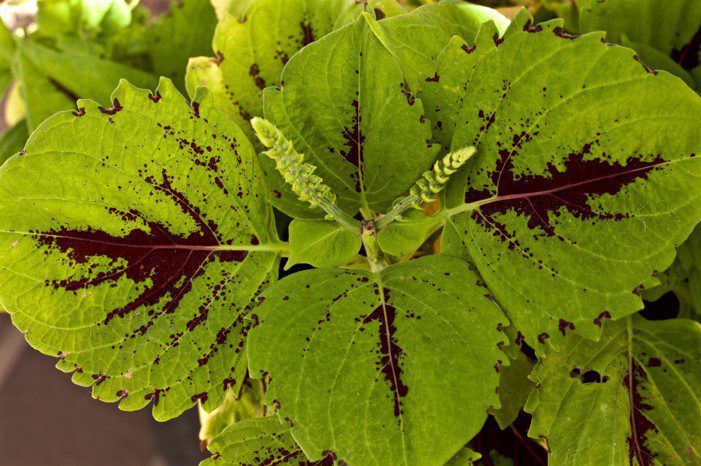Coleus Information
Coleus belongs to the genus of herbaceous tropical plants, with most of our cultivated species originating in Southeast Asia, Java, and Malaysia. It falls into the mint family, along with nettles and other familiar herbs.
It is technically perennial, but only in frost-free climates. Everywhere else, it should be considered an annual grown for its foliage, not flowers.
Few plants have more leaf form, vibrant color, or more interesting variegations than the coleus.
Considered the most versatile of garden foliage, the different strains of the plant are popular throughout the world for bedding schemes, annual or mixed borders, and as pot plants.
Their gay coloring also makes them useful for interior decoration work, and they do well during short stints indoors.
In the tropics, they grow the whole year; in other climates, they are summer flowering. The plants are straightforward to cultivate, fast-growing, and dependable. Their leaves are white, cream, yellow, light and dark green, pink, red and crimson.
Furthermore, they have a wide range of variegations with all sorts of patterns and color combinations. Also, there are many different kinds of leaf patterns, sizes, and margins.
Such a multiplicity of combinations and variations make the plants, if grown in groups, excellent as unique, colorful accent clumps in a sunny, mixed border.
The coleus also produces small flowers, usually pale blue or lavender. For best foliage results, however, flowering spikes should be removed as soon as they emerge.
This will ensure that all energy and plant nutrients are conserved for plant growth and development only.
The plants possess square stems (in cross-section) about 5mm in size. The leaves are large, up to 10cm long.
Coleus Care
Being tropical in origin, the coleus loves good sunshine and abundant moisture. But they thrive best if they have some shelter from the hot sun.
The soil has to be well prepared beforehand as good drainage is essential. This would allow the roots to develop unhindered; any water- logging would be fatal.
All planting beds in the open should contain ample, coarse material like coarse river sand to increase the porosity of the soil for effective drainage.
A generous application of well-rotted organic manure, compost, or an organic soil conditioner like peat should be included. This will maintain a good level of moisture in the soil for the benefit of the root systems.
The soil should be reasonably rich, with a pH of 6-7. Sometimes, through constant usage or the application of organic manure, the soil may become a little acidic because of the accumulation of organic acids, and this can be easily remedied by putting a little ground magnesium limestone (GML) dust to the soil, say, one or two handfuls to a square meter of soil.
This GML must be worked into 15-20cm of soil to neutralize the acidity. Most plants in the tropics prefer a pH of 6 but will tolerate a value near to neutral or even a little towards alkalinity.
Coleus can be raised from selected seeds or stem cuttings of top pieces 10cm long. Cut just below a node (leaf junction with the stem) and trim off half the leaves.
A cutting with some leaves attached will root more readily than cuttings with no leaves attached. As long as the stem cuttings continue absorbing water, the leaves will continue with the photosynthetic process to nourish the formation of new roots.
Insert the stem cuttings into a rooting medium consisting of soil, peat, and sand in the ratio of 1:1:1. Once planted, the pot should be kept damp and in a cool place.
Growing Coleus From Seed
The coleus is also easily planted from packet seeds. Sow these thinly in prepared seedboxes or pans. It is much more economically feasible to grow them and transplant the seedlings when they are big enough. This usually entails at least three steps.
First, sow the seeds very thinly. (For a more even sowing, mix the fine seeds thoroughly with half a teacup of fine sand.) Then sprinkle a light covering of sifted soil over the seeds, and firm down the soil with a flat board.
Water sufficiently to keep the soil moist. (If you are using a seedbox, hold the box over basin water and allow water to seep in through the drainage slits at the bottom).
Second, prick out the seedlings when they are large enough to be handled and transplanted into small polybags or pots.
Finally, plant these seedlings in their permanent positions in open beds or pots.
In all these stages, watering is essential and should be carried out regularly to ensure no moisture stress.
Otherwise, plant growth will be adversely affected or even stunted. When the plants are four to five weeks old, weekly or bi-weekly liquid fertilizer applications will help boost growth.
Pruning
Plants at this stage should be pinched back – remove the young growing tips – to encourage lateral branching. Constant pinching will result in a bushier plant.
In pot culture, pinching (the most elementary form of pruning) is always done to ensure the plant “opens up” into a much wider foliage coverage with more flowering spikes if it is a flowering plant because more laterals mean more flowering potentials.
Mulch the soil surface with dried lawn clippings or coarse peat to help conserve moisture, suppress weed growth, and keep the soil cool. All this makes for healthier plant growth.























